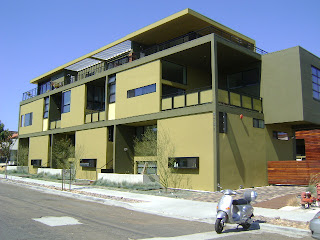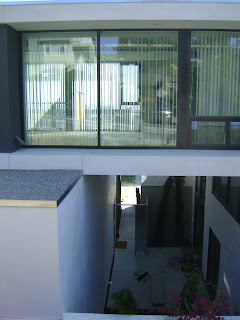
Clean and white against the cacophonous funk of Midtown, Jonathan Segal’s latest venture, the Charmer, could be a lost piece of Stuttgart’s famous Weissenhofsiedlung of 1927. The Bauhaus inspired architects of the Weimar Republic were exploring industrial and scientifically based models of living to replace traditions challenged by technology and rapid urban growth. Here, San Diego’s most visible architect/developer continues to explore the intricacies of traditional row homes and, in these economically anorexic times, maintain a positive spreadsheet. Corbu and Mies may have asked “architecture or revolution?” but Segal might ask “architecture or recession?”
Crisp volumes etched with elegantly proportioned black window frames step down a hillside site towards busy, one-way India Street. Here in Midtown India loses its Little Italy charm and functions more as a freeway access road. This nowhere land non-appeal has invited the appearance of a couple of outliers of hipdom – the Starlight, the Regal Beagle and retro-dive bar Aero among others. They blend in well with long time neighborhood stalwarts, El Indio and Shakespeare & Co. Charming in their own way, the bungalows and ‘50s apartments, car repair and other gritty services provides Segal’s project a messy counterpoint to the self contained “calme, luxe et volupte” qualities of this neo-modernist exercise.
From the street, the Charmer provides few clues to the individual unit layouts, aiming for a larger compositional unity with those large open windows, open walkways, balconies and expanses of white stucco, while the enigmatic entries within the court coyly declaim their physical separation. Here the ghost of Segal’s previous etudes on the row house model are apparent - and these post-modern and neo-traditional elements rub shoulders well with Segal’s new International Style moves.
The elongated proportions of the entries, flanked as they are by skinny cypresses, betray a certain soignee Hollywood Regency elan, but the atavistic simplicity of the ka’bah reminiscent black asphalt shingle covered cubes immediately sobers up any playfulness. Where a ‘80s architect may have joked it up with a fake wall or a twee reference to Palladio, Mr. Segal plays it straight. This is serious good work – jokey one-liners are not Mr. Segal’s style.
And jokes are luxuries in this economy, but several years ago Segal made a very cheeky one by framing, on the walls of the Museum of Contemporary Art in La Jolla, not renderings or professional photographs of his projects, but financial pro forma for several of his design/build projects. Pulling back the curtain on the “art of the deal” he was characterized as a walking, talking, designing Howard Roark manqué – and was criticized by some aesthetic mandarins for being financially involved with projects where his bottom line could trump his aesthetic aspirations.
Whether through luck or a strategic decision to play the rental market rather than the condo market, Mr. Segal thrives where other architects, and their aesthetic aspirations, struggle. Segal continues to champion the DIY aesthetic and economics of the design/build model. Like the Farm-to-Table movement, Segal’s design/build strategy is based on locally available resources and - more critically – local demand. Given the continuing flat state of the economy, Mr. Segal’s ventures and their financial and aesthetic success are remarkable, and the success of the Charmer is a sign of hope for a more intimate integration of the building site, construction techniques, design, designer and the public that uses the building.
Consisting of two more or less U shaped buildings surrounding a parking/entry courtyard, the project is remarkable for the apparent openness of the units – window treatments will be in demand- and the embrace of one California tradition often praised but rarely revived – the bungalow court. Esther McCoy’s “The Second Generation” must have been a constant reference point for the design team. This neo-modernist touchstone is certainly “The American Vignola” for a certain generation of California architects, and whether generally referencing Corbusier’s Villa Savoye or possibly Raphael Soriano’s Colby Apartments of 1952, the focus on the courtyard pays deep homage to McCoy’s sensibilities regarding the possibilities of civilized and gracious accommodations for communal living.
The courtyard is carefully arranged composition of landscape and building that – seriously – must be the best outdoor space built in San Diego since Louis Kahn’s courtyard at the Salk. Shaded with Chinese Elms, the courtyard has a casual but formal air – European, almost French, but not doctrinaire and certainly unexpected. An allee of trees frames a tapis vert, but the vista leads to a bit of borrowed landscape from the car repair shop next door. The object of desire is to the right of the classical axis where – folly like, truly the machine in the garden- a more luxurious apartment unit takes on the light hearted seriousness of Gabriel’s Pavilion at Versailles, though in glass and stucco and bereft of putti or allegorical groupings. Happy tenants will celebrate summer not with a suburban barbeque but with a hipster fete galante.
The Charmer celebrates this place between the units – where before - at least on Mr. Segal's stern pro forma, only each unit’s financial stats would have been honored. I think Esther would be happy here. And that is saying something.
















